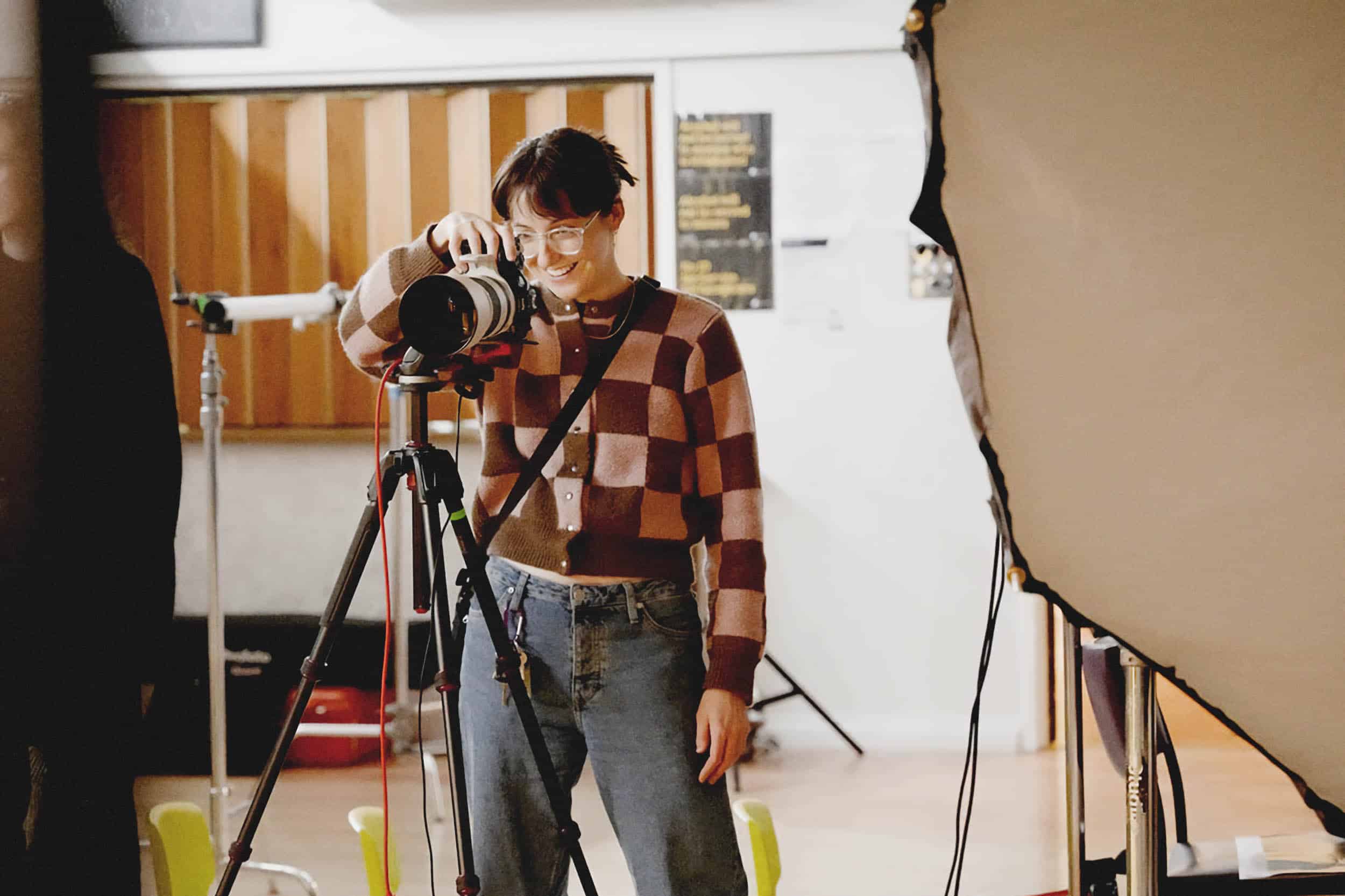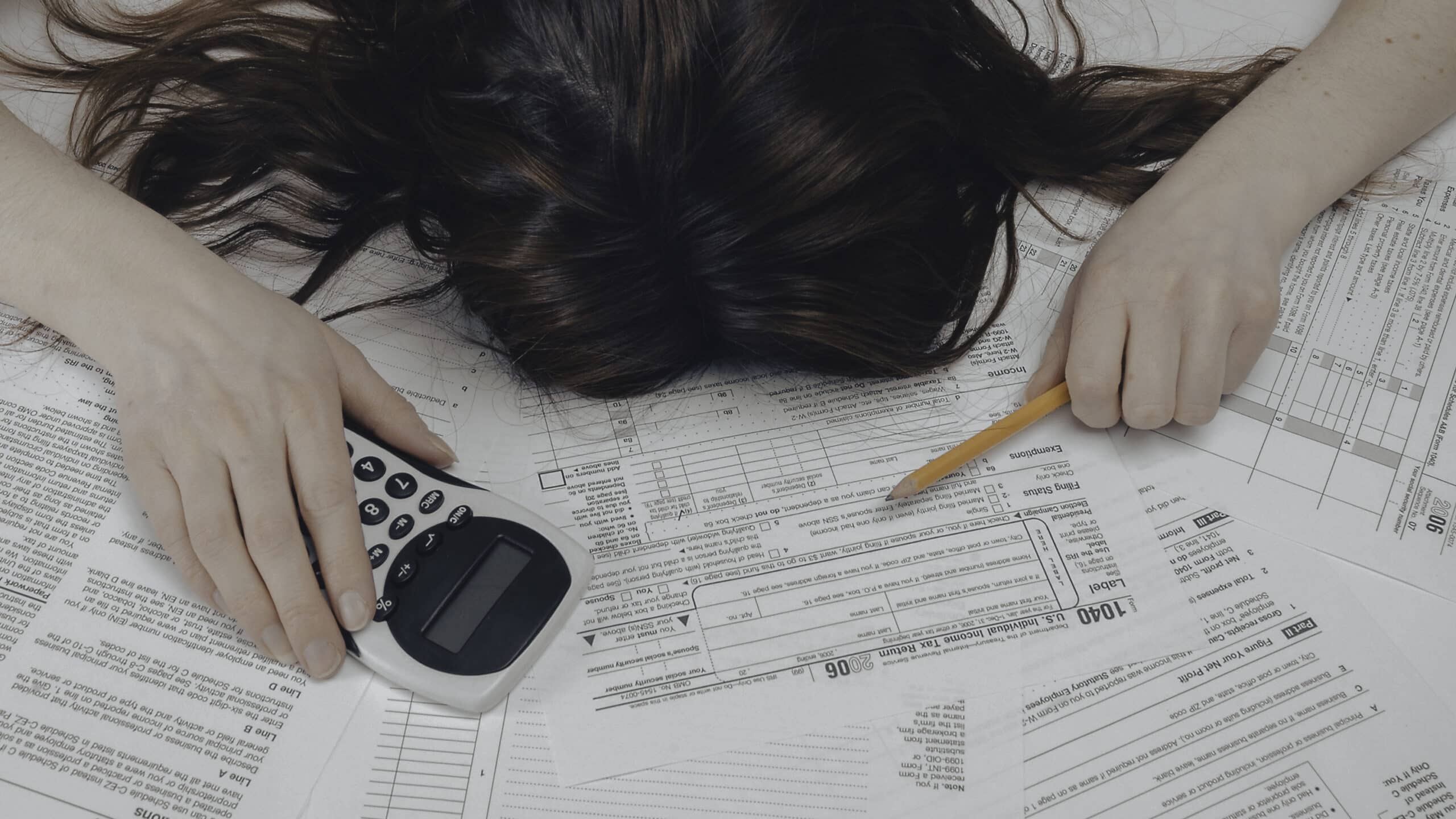In diesem Artikel geben wir Empfehlungen von etablierten Künstlerinnen und Künstlern, wie du ein profitables Jahr verbringen kannst. Die hier vorgestellten Tipps sind bewährte Vorschläge, wie du dein kleines Unternehmen für den Verkauf deiner Arbeiten organisieren kannst. Die Zeitpläne und Beispiele dienen nur als Anregung, aber wenn du diese Art von Arbeitsablauf befolgst, wird er dir helfen, dich für den Online-Verkauf zu organisieren.
In diesem Artikel geht es um Themen wie: Zeitplanung, Marketing und Preisgestaltung. Am wichtigsten ist, dass wir uns damit beschäftigen, wie du einen Zeitplan für den Verkauf erstellst. Wenn du mit dem Liefertermin beginnst und dich dann durch alle Schritte zurückarbeitest, die du für den Verkauf deiner Arbeit benötigst, hast du genügend Zeit, um deine Arbeit zu erstellen, zu vermarkten, zu verkaufen und zu verschicken - und das erspart dir eine Menge Stress und Rätselraten.
Identifiziere die wichtigsten Verkaufsargumente im Laufe des Jahres
Für einige ist der Laden das ganze Jahr über geöffnet, für andere richtet sich der Verkauf nach wichtigen Ereignissen wie Kunstmärkten, Ausstellungen oder Messen. Unabhängig von deinem Geschäftsmodell ist es eine gute Idee, einen Kalender mit den wichtigsten Verkaufsterminen zu erstellen, um deinen Werbekalender zu strukturieren.
Abhängig von verschiedenen Faktoren können deine Haupttermine stark variieren. Für Künstlerinnen und Künstler in Kanada haben wir hier ein paar Eckdaten zusammengestellt, nach denen du deinen Zeitplan ausrichten kannst, wenn du in der Herbstsaison beginnst:
- Winterferien Sale Aktion: 1. November - 13. Dezember
- Valentins Cyber Promotion: Jan 16 - Feb 1
- Einzigartige Show: 27. bis 31. März
- Toronto Outdoor Art Show: 5. bis 8. Juli
- CyberSale/Open Studio am Ende des Sommers: 19.-30. August
- August nächsten Jahres: Beginn des Bestandsaufbaus für die kommende Urlaubssaison
Eine weit verbreitete Praxis ist es, Verkäufe rund um die großen Feiertage zu planen, wenn die Menschen auf der Suche nach einzigartigen Geschenken sind. In diesem Artikel nehmen wir Weihnachten als Beispiel. Wir alle wissen, dass November und Anfang Dezember die Haupteinkaufszeiten für saisonale Feiertage wie Chanukka, Kwanzaa und Weihnachten sind. Aber wusstest du, dass die Planung der Website bereits im August und September beginnen sollte, um die wichtigsten Verkaufstermine zu erreichen?
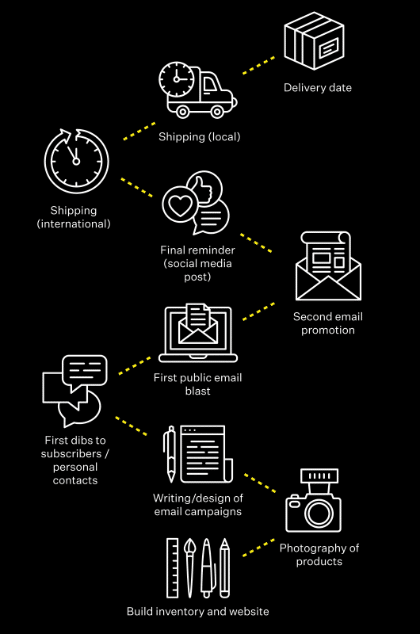
Einen Zeitplan für das Workback erstellen
Rückwirkungspläne sind genau das, wonach sie klingen: Du fängst mit dem Enddatum an und arbeitest dich mit den wichtigsten Ergebnissen deines Projekts zurück, indem du die Zeit berechnest, die du für jede Aufgabe brauchst, bis du wieder zu deinem Ausgangspunkt zurückkehrst. Die Termine in diesem Artikel können als Schätzung oder Anregung dienen.
Dein eigener Zeitplan für das Workback hängt von verschiedenen Faktoren ab:
- die Zeit, die du brauchst, um deine Arbeit zu produzieren
- Zeit für externe Produktion (wie Druck oder Rahmung)
- wo du dich befindest und wohin du deine Arbeit lieferst
- und mehr.
Wir haben einen Musterzeitplan erstellt, um die Arten von Lieferterminen zu zeigen, die du bei der Erstellung deines eigenen Zeitplans für die Nacharbeit berücksichtigen solltest.
Plan für den Versand
Wenn dein Liefertermin auf Weihnachten fällt, solltest du dein letztmögliches Lieferdatum ein paar Arbeitstage vorher festlegen. Das ist eine gute Vorgehensweise, um eventuelle Probleme beim Versand in letzter Minute zu berücksichtigen. Dein letztmögliches Lieferdatum ist also der 20. Dezember. Du solltest auch bedenken, dass der Versand um die Feiertage langsamer ist. Wir empfehlen daher, für den lokalen Versand mindestens eine Woche und für den nationalen und internationalen Versand mindestens zwei Wochen einzuplanen.
So könnte die Aufschlüsselung aussehen:
- Lokaler Versand: Versand mindestens 1 Woche im Voraus = 13. Dezember
- Internationaler Versand: Versand mindestens 2 Wochen im Voraus = 6. Dezember
Das bedeutet, dass für lokale Kunden der 13. Dezember als Stichtag für die Bestellung gilt und für internationale Kunden der 6. Dezember.

Vermarktung deines Verkaufs
Der nächste Schritt in deiner Arbeit ist das Marketing - Mails und Posts in den sozialen Medien. Du brauchst ausreichend Zeit für Werbeaktionen, um die Kunden überlegen zu lassen. Es kann auch hilfreich sein, ein paar gezielte Erinnerungs-E-Mails oder -Posts zu verschicken, um die Leute an deine Bestellfristen zu erinnern.
Jedes Mal, wenn du eine E-Mail schreibst, solltest du auch eine Erinnerung in den sozialen Medien einfügen. Je nachdem, wo sich dein Publikum aufhält, kann das ein Instagram-Post oder eine Story, ein Tik-Tok oder ein FB-Post sein. Auf einigen Kanälen, wie z. B. Instagram, kannst du deinen Posts Kalendererinnerungen oder eine Countdown-Uhr für Verkäufe und Werbeaktionen hinzufügen.
In diesem Beispiel für E-Mail- und Social-Media-Marketing würden die Termine wie folgt aussehen, beginnend mit dem Datum deiner letzten Erinnerungen:
- 12. Dezember: Letzter Aufruf / letzter sozialer Beitrag. Informiere deine Follower in den sozialen Medien und die Öffentlichkeit darüber, dass der 13. Dezember der letzte Tag ist, an dem sie noch bestellen können. Dies ist ein guter Zeitpunkt, um die Countdown-Uhren zu nutzen, die auf den sozialen Plattformen verfügbar sind.
- 6. Dezember: Letzte Erinnerungsmail. Diese letzte E-Mail Betreff: Letzte Chance für lokale Lieferungen. Sag deinen E-Mail-Kontakten, dass die letzte Bestellfrist für lokale Lieferungen am 13. Dezember abläuft.
- 29. November: E-Mail und soziale Medien. Poste deine vierte Erinnerung in den sozialen Medien und die zweite Erinnerung per E-Mail. Ein Beispiel für einen E-Mail-Betreff: Erinnerung an die letzte Chance für nationale und internationale Lieferungen. In beiden E-Mails informierst du die Leute darüber, dass der letzte Tag für die nationale und internationale Lieferung der 6. Dezember ist.
- 22. November: E-Mail und soziale Medien. Teile an diesem Tag sowohl deinen dritten Marketing-Post in den sozialen Medien und die erste Erinnerungsmail an deine Mailingliste. An dieser Stelle könntest du ein bestimmtes Produkt hervorheben. Die Grafiken in dieser E-Mail sollten sich von denen in der Early-Access-E-Mail unterscheiden.
- 15. November: Werbung in sozialen Netzwerken: In deinem zweiten Marketing-Post in den sozialen Medien erinnerst du deine Follower daran, dass der Laden geöffnet ist.
- 7. November: Erste öffentliche Werbung in sozialen Netzwerken. Dieses Datum wird dein erster Marketing-Post in den sozialen Medien sein, in dem du die Eröffnung des Ladens bekannt gibst. Das Ziel dieses Posts ist es, neue Kunden zu gewinnen.
- 1. November: Private E-Mail an Mailinglisten/Abonnenten/persönliche Kontakte. Gib deine private Mailingliste eine Woche vor der allgemeinen Öffentlichkeit frei. Mit dieser E-Mail kannst du Menschen belohnen, die schon einmal bei dir gekauft haben oder sich die Zeit genommen haben, deine Website zu abonnieren. Die E-Mail könnte einen Rabatt und/oder einen frühen Zugang zu den Verkaufsartikeln enthalten. Dieser frühe Zugang ermöglicht es den Leuten auch, sich über ihren Geschenkbedarf Gedanken zu machen und vorauszuplanen.
Alle Posts in den sozialen Medien, die außerhalb der angegebenen Daten erfolgen, sollten sich nicht auf den Verkauf beziehen. Wenn du täglich oder ein paar Mal pro Woche etwas postest, ist es am besten, wenn du bei deinen üblichen Inhalten bleibst, anstatt dein Publikum mit Posts zu überschwemmen, die sich speziell mit dem Verkauf deiner Arbeit befassen. Deine Standardbeiträge sind einer der Gründe, warum sie dir überhaupt folgen!
Jetzt, wo wir den Zeitplan für das Marketing haben, ist es an der Zeit, ein bisschen weiter zurückzugehen und die Termine für die Erstellung deiner Marketingmaterialien und die Einrichtung deines Onlineshops festzulegen.
- 25. Oktober: Schreiben und Gestalten von E-Mail-Kampagnen. Wenn du noch nicht damit angefangen hast, solltest du bis zu diesem Zeitpunkt deine Grafiken erstellen und entscheiden, welche Bilder deiner Arbeit in deinen sozialen Netzwerken und E-Mails zu sehen sein werden. Es ist auch wichtig, die E-Mails und Bildunterschriften für die sozialen Medien jetzt zu schreiben, damit die Schreibblockade deinen Marketingplan nicht verzögert.
- 11. Oktober: Fotografieren und Vorbereitung der Produkte. Nimm dir etwa 2 Wochen Zeit, um die Fotobearbeitung der Produkte abzuschließen, sie zu deinem Laden hinzuzufügen, Werbeaktionen auf deiner Website zu erstellen usw.
- 13. September: Inventar erstellen und Website aktualisieren. Wenn du bis zu diesem Datum noch nicht damit begonnen hast, solltest du den nächsten Monat nutzen, um zu produzieren, zu drucken usw. und sicherzustellen, dass du deinen gewünschten Bestand an Arbeiten zum Verkauf bereit hast. Das ist ein guter Zeitpunkt, um einen kurzen Blick auf deine Website zu werfen und sicherzustellen, dass die Bilder auf deiner Homepage deinen aktuellen Bestand widerspiegeln.
Jetzt, wo du deinen Zeitplan für das Workback festgelegt hast, findest du hier eine kurze Übersicht über die benötigten Marketingmaterialien:
- Vier MailsEs gibt zwei einzigartige E-Mails, die E-Mail mit dem frühen Zugang für Abonnenten und die E-Mail, die einen Artikel aus deinem Werk hervorhebt, und zwei, die im Wesentlichen gleich sind. Diese beiden ähnlichen E-Mails sind die "letzte Chance" für die lokale Zustellung und für die nationale/internationale Zustellung.
- Vier bis sechs soziale Beiträge: Die letzten beiden kündigen die "letzte Chance" für die lokale Lieferung und für die nationale/internationale Lieferung an; die andere kündigt an und erinnert die Follower daran, dass dein Laden geöffnet ist. Diese können Beispiele deiner Arbeit, kurze Scrolls deines Onlineshops oder Grafiken mit Daten enthalten. Achte darauf, dass deine Überschriften klar sind und wichtige Daten oder andere Informationen enthalten.
Best Practices für E-Mails
Diese gehen an deine Mailingliste und an die Menschen, die sich für deine Arbeit interessiert haben. Deine Mailingliste kennt dich bereits, also biete ihnen ein paar Details/Aktualisierungen, die sie wieder ansprechen. Anstatt diese E-Mail geschäftsmäßig und rein verkaufsorientiert zu gestalten, erzähl ihnen ein bisschen über die Hintergründe deiner Arbeit. Eine andere Idee wäre, einen Rückblick auf das vergangene Jahr zu geben.
Bedanke dich bei deiner Mailingliste für ihr anhaltendes Interesse an deiner Arbeit und verbinde dies mit einem Sonderangebot zu deinem Weihnachtsgeschäft - erhalten sie frühzeitig Zugang zu deiner Preisliste, um eine Auswahl zu treffen? Bekommen sie einen Rabatt? Indem du diejenigen belohnst, die Interesse an deiner Arbeit gezeigt haben, ermutigst du sie, deiner Website und deinen sozialen Netzwerken treu zu bleiben und ermutigst sie zu weiteren Verkäufen.
Glaube nicht, dass du mit deiner Ästhetik zu weihnachtlich sein musst, es sei denn, es macht Sinn für deine Arbeit. Es ist die Zeit des Jahres, in der es scheint, als würde jeder ein Stechpalmenbanner oder einen Tannenbaum auf seine Grafiken setzen. Das Gleiche gilt für andere Feiertage, die mit Geschenken, dem Verkauf deiner Arbeit und Werbeaktionen zu tun haben.
Manche Künstler/innen gehen anders vor und finden Wege, ihre Werke in ihrem Stil und mit ihrer Freude an der Saison zu gestalten. So hat zum Beispiel ein Landschaftsmaler in unserer Gemeinde eine spezielle Serie von Winterbildern gemalt und diese über die Feiertage vermarktet. Ein Porträtfotograf konzentrierte sich auf den Verkauf von Familienfotos, die zu dieser Jahreszeit besonders gefragt sind.
Unabhängig davon, ob die erwarteten Artikel dein Urlaubserlebnis widerspiegeln oder nicht, solltest du dich fragen: "Wie kann ich mich optisch abheben?" Erstelle dann für jede E-Mail/jeden Post in deiner Serie für das Ereignis ein einzigartiges Bild/Design, damit jede Kommunikation frisch wirkt.
Best Practices für soziale Medien
Ähnlich wie bei deinen E-Mail-Grafiken sollte auch das Bildmaterial für jeden Social Post einzigartig sein (d.h. ein anderes Foto/ein anderes Bild in jedem Post). Damit alles zusammenhängend bleibt, solltest du dir eine verbindende Grafik oder ein Banner ausdenken, das deinem Publikum zeigt, dass dieser Inhalt mit dem Verkauf zusammenhängt. Überlege dir, ob du deine Bilder mit einem minimalen Text zu deinem Angebot oder einem Banner formatieren willst, das einen Teil des Bildes überdeckt. Wenn du einzigartige Stücke vorstellst, bleiben die Beiträge frisch und steigern das Interesse an den verschiedenen Werken, die du zum Verkauf anbietest.
Formuliere in deinen letzten Beiträgen explizit die Fristen für den Versand. So kannst du diejenigen einfangen, die mit dem Gedanken gespielt haben, etwas zu kaufen. Vermitteln Sie mit diesen Hinweisen ein Gefühl der Dringlichkeit. Zum Beispiel: Noch eine Woche bis zum Kauf für lokale Lieferungen.
Wenn du Instagram nutzt, könntest du sogar Countdown-Timer in den Stories verwenden; beginne damit, Vorschauen von Arbeiten zu posten, die zum Verkauf stehen werden, und mache ein Event über die Veröffentlichung von Arbeiten für deinen Weihnachtsverkauf.
Manche Künstler/innen verkaufen nur zu bestimmten Zeiten im Jahr im Rahmen von Studioverkäufen - das schafft bei ihren Follower/innen in den sozialen Medien ein Gefühl der Knappheit. Ihre Verkäufe werden zu Ereignissen mit Countdown-Zeiten und Erinnerungen an das Ereignis, die in die Werbung in den sozialen Medien integriert werden.
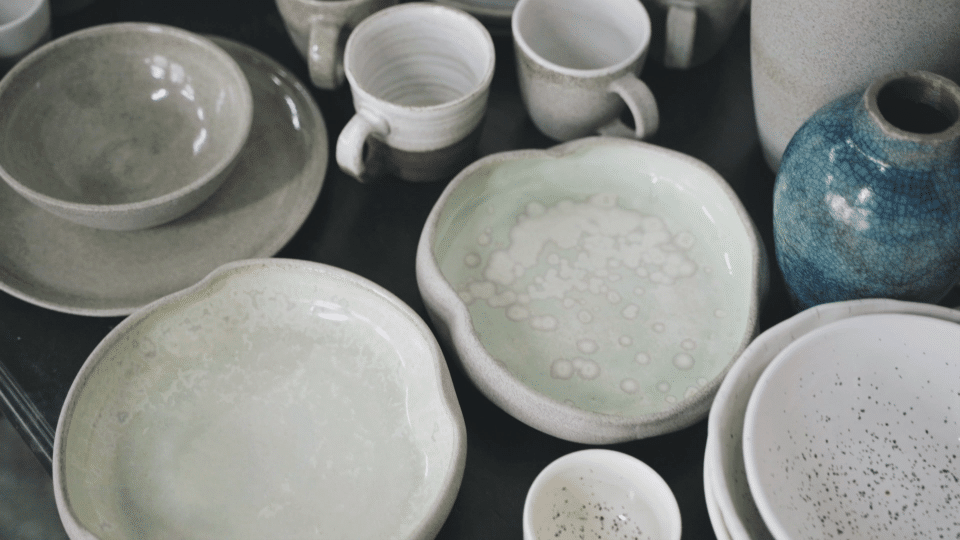
Preisgestaltung deiner Arbeit
Es gibt keine feste Formel für die Preisgestaltung deiner Arbeit. Es gibt jedoch immer ein paar Dinge, die du bei der Festlegung deiner Preise berücksichtigen solltest. Diese helfen dir dabei, einen Basiswert für deine durchschnittlichen Stücke zu finden, und von dort aus kannst du eine Kalkulation für Arbeiten anderer Größen oder Ausführungen erstellen.
Dies sind die wichtigsten Dinge, die du bei der Festlegung deiner Preise berücksichtigen musst:
- Die Kosten für deine Materialien/Produktion.
- Deine Kosten für Marketing und Verpackung.
- Die Kosten für deine Zeit, um die Arbeit zu erstellen.
- Andere Geschäftsausgaben, wie z.B. ein Atelier, eine Online-Portfolio-Website und mehr.
Bei einmaligen Produkten wie Originalgemälden solltest du generell mehr Zeit einplanen als bei Produkten wie einem Fotodruck oder einer gedruckten Kopie eines Originalwerks, die mehrmals aufgelegt und verkauft werden können.
Achte vor allem darauf, dass du dich nicht unter Wert verkaufst - zu oft bewerten aufstrebende Kreative ihre Arbeit so niedrig, dass sich ihre Investition nicht lohnt. Überdenke deinen eigenen Zeitaufwand und deine Kosten und vergleiche sie mit den Preisen, die deine Kollegen und Mitglieder deiner kreativen Gemeinschaft für ihre Arbeit verlangen.
Wenn du zum ersten Mal versuchst herauszufinden, wie du den Preis für deine Arbeit festlegen sollst, ist es hilfreich, sich die Preislisten bei Galerieausstellungen anderer aufstrebender Künstler/innen anzusehen und den Wert der Arbeiten auf Websites wie Artsy zu prüfen. Finde heraus, wie hoch dein Marktwert ist, und lege einen Grundpreis fest. Sobald du einen Grundpreis für deine Kunst festgelegt hast, kannst du einen Preisrechner verwenden, um die Preise für den Rest deiner Arbeit festzulegen.
Beispiel für einen Preiskalkulator: Wenn dein durchschnittliches Gemälde 18 x 20 groß ist und du den Preis für dieses Stück auf $500 festlegst, kannst du einen Preis pro Zoll für dein Werk festlegen.
18 x 20 = 360 Quadratzoll 500/ 360= $1,38 pro Quadratzoll
9x 12 = 108 sq inches x $1.38 = $150 Verkaufspreis
Natürlich kannst du diese Berechnung als Ausgangspunkt nehmen und dann deine Preise auf- oder abrunden, um sicherzustellen, dass sie einheitlich sind.
Verbinde deine Werbeaktionen mit deiner Website
Es ist sehr sinnvoll, deine Werbeaktionen mit deiner eigentlichen Website zu verbinden. Bevor du mit diesem Prozess beginnst, solltest du deine Online-Portfolio-Website eine kurze Überprüfung, um sicherzustellen, dass sie bereit ist, den Besuchern eine klare Vorstellung davon zu vermitteln, wer du als kreativer Profi bist und was du kreierst. Je besser das Erlebnis beim Besuch deiner Website ist, desto wahrscheinlicher ist es, dass die Leute einen Kauf tätigen und später wiederkommen, um mehr von deiner Arbeit zu sehen.
Verfolge deine Kontakte mit einer benutzerdefinierten Landing Page
Das Wachstum deines Unternehmens hängt mit dem Wachstum deiner Zielgruppe und deiner Kontaktliste zusammen. Die sozialen Medien spielen dabei eine große Rolle, aber sobald du Leute auf deine Website gelockt hast, kannst du ihre Daten mit einer Mailingliste und/oder Pop-ups erfassen. Eine spezielle Landing Page, die über dein Angebot informiert, ist ein guter Ort, um eine Mailingliste auf der Seite einzurichten oder ein Pop-up einzubauen. Wenn du den Abonnenten deiner Mailingliste während der Eröffnung deines Onlineshops Rabatte anbietest, kannst du das in die Mailingliste einbauen, um sie darüber zu informieren. Wenn du den Leuten mitteilst, dass sie einen Rabattcode für den Verkauf erhalten, wenn sie sich anmelden, vermittelt das ein Gefühl der Dringlichkeit und kann zu mehr Anmeldungen für deine Liste führen.
Wenn du eine benutzerdefinierte Landing Page mit Informationen über deinen Verkauf erstellst, empfehlen wir, dass sie Folgendes enthält:
- Ein Link zu deinem Laden
- Wichtige Daten für den Verkauf, wie z.B. der Beginn und die Bestellfristen für den lokalen und internationalen Versand.
- Mailingliste auf der Seite anmelden oder Pop-up
- Bilder von deiner Arbeit und/oder Aufnahmen aus dem Studio
- Alle häufig gestellten Fragen und ihre Antworten; das können Fragen sein, die bei früheren Verkäufen aufgetaucht sind, oder Fragen von Freunden oder Verwandten, die du gebeten hast, deinen Laden zu besichtigen, bevor du ihn der Öffentlichkeit zugänglich machst.
Sobald du anfängst, Verkäufe zu tätigen und eine Beziehung aufzubauen, kannst du mit Tools deines Website-Hosts wie Arbeitsablauf kann bei der Kontaktverwaltung helfen. So hast du alles an einem Ort und kannst nahtlos verkaufen und nachverfolgen.
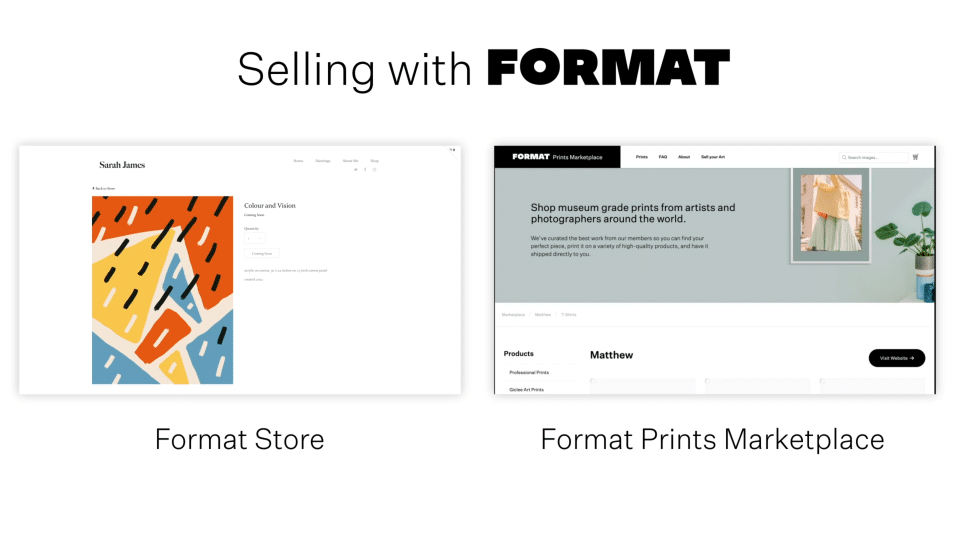
Verkaufe deine Arbeit über deine Format-Website
Bei der Auswahl der Produkte, die du zum Verkauf anbietest, empfehlen wir dir, die Artikel deines Ladens so zusammenzustellen, wie du es bei einer Portfolio-Galerie tun würdest. Wenn du zu viele ähnliche Produkte auf einmal anbietest, kann es für die Besucher/innen schwieriger werden, sich zu entscheiden.
Es gibt viele Möglichkeiten, deine Werke zu verkaufen, von Galerien über lokale Kunstmärkte und Online-Marktplätze bis hin zu individuell gestaltbaren Websites. Format-Mitglieder können ihre Werke direkt über ihre Website verkaufen, und zwar mit dem Funktion speichern oder nutzen Sie die Marktplatz für Drucke für die Selbstverwirklichung von fotografischer und digitaler Kunst.
Vorteile des FORMAT STORE:
- Verkaufe ein physisches Produkt, eine Dienstleistung oder einen digitalen Download*.
- Verbunden durch Paypal für eine einfache, internationale Zahlungsabwicklung
- Die Selbstabwicklung von Produkten bedeutet, dass du deine eigenen Produktionsanlagen und Versandoptionen nutzen kannst
- Auf Verkäufe von Format werden keine Provisionen erhoben, sodass du alle Gewinne aus den Verkäufen behältst.
Vorteile des PRINTS MARKETPLACE:
- Nur für Fotos und digitale Bilder*
- Verbunden durch Stripe für einfache Zahlungsabwicklung
- Auto Fulfillment durch unsere Druckpartner bedeutet, dass wir den Druck und Versand in deinem Namen übernehmen.
- Du hast keine Vorlaufkosten für die Produktion - die Lieferung erfolgt auf Anfrage.
- Kleine Provision aus dem Verkauf (15% pro, 5% pro plus)
- Sieh die Produktionskosten im Voraus, um die Preisgestaltung für deine Produkte zu erleichtern.
Bist du bereit zu verkaufen? Du kannst Teste Format kostenlosund erfahre mehr in unserem Webinar über den Online-Verkauf deiner Arbeit.






